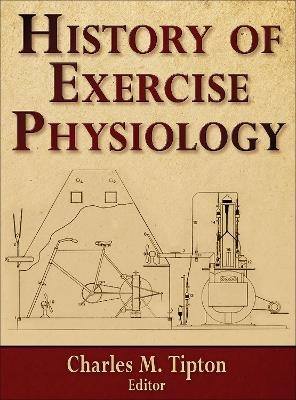
History of Exercise Physiology
Human Kinetics (Verlag)
978-0-7360-8369-0 (ISBN)
- Titel z.Zt. nicht lieferbar
- Versandkostenfrei
- Auch auf Rechnung
- Artikel merken
History of Exercise Physiology brings together leading authorities in the profession to present this first-of-its-kind resource that is certain to become an essential reference for exercise physiology researchers and practitioners. The contributing authors were selected based on their significant contributions to the field, including many examples in which they were part of seminal research. The result of this vast undertaking is the most comprehensive resource on exercise physiology research ever compiled.
Exercise physiology research is ongoing, and its knowledge base is stronger than ever. But today’s scholars owe much of their success to their predecessors. The contributors to this book believe it is essential for exercise physiologists to understand the past when approaching the future, and they have compiled this reference to aid in that process. The text includes the following features:
• A broad scope of the primary ideas and work done in exercise physiology from antiquity to the present
• A review of early contributions to exercise physiology made by Scandinavian scientists, the Harvard Fatigue Laboratory, German laboratories, and the Copenhagen Muscle Research Centre
• The incorporation of molecular biology into exercise biology and physiology research that paved the way for exercise physiology
• An explanation of the relationship between genomics, genetics, and exercise biology
• An integrative view of the autonomic nervous system in exercise
• An examination of central and peripheral influences on the cardiovascular system
• An in-depth investigation and analysis of how exercise influences the body’s primary systems
• A table in most chapters highlighting the significant research milestones
Well illustrated with figures and photos, History of Exercise Physiology helps readers understand the research findings and meet the most prominent professionals in the field. From studying great thinkers of antiquity and cutting-edge work done by pioneers at research institutions, to exploring the inner workings of all the body’s systems, researchers will gain a precise understanding of what happens when human bodies move—and who influenced and furthered that understanding.
Charles M. Tipton, PhD, is an active emeritus professor of physiology at the University of Arizona. He received a PhD in physiology from the University of Illinois in 1962. He retired after 35 years of directing exercise physiology laboratories that investigated physiological mechanisms associated with the effects of acute and chronic exercise. He is recognized as a leading authority of exercise physiology. Professor Tipton taught physiology and exercise physiology courses to undergraduate, graduate, medical, and professional students at the University of Iowa and the University of Arizona and mentored 21 PhD students at these locations. He has written, coauthored, or edited six books, 33 chapters and proceedings, and approximately 18 articles. In addition, he served as editor in chief of Medicine and Science in Sports and Exercise and was an associate editor of the Journal of Applied Physiology for nearly a decade. He has been both member and chair of select National Institutes of Health (NIH) study sections and of several American College of Sports Medicine (ACSM) research committees. A past president of ACSM, Professor Tipton has been appointed to many microgravity advisory committees that include the NASA Review Panel on Space Medicine and Countermeasures, the External Advisory Committee for the National Space Biomedical Research Institute (NSBRI), and the Congress-directed National Research Council Steering Committee on Recapturing a Future for Space Exploration. For his research and professional endeavors, he received Honor Awards from the ACSM and from the Environmental and Exercise Physiology Section of the American Physiological Society. Fellow Tipton also received the Clark W. Hetherington Award from the National Kinesiology Academy.
Part I: Antiquity, Early Laboratories, and Entering the 21st Century
Chapter 1.
Antiquity to the Early Years of the 20th Century
Charles M. Tipton
Chapter 2.
Influence of Scandinavian Scientists in Exercise Physiology
P.-O. Åstrand
Chapter 3.
Contributions From the Harvard Fatigue Laboratory
Charles M. Tipton and G. Edgar Folk, Jr.
Chapter 4.
Contributions From German Laboratories
Wildor Hollmann
Chapter 5.
PhD Specialization and Incorporating Molecular Biology Into Exercise Biology and Physiology Research
P. Darrell Neufer and Charles M. Tipton
Chapter 6.
Contributions From Copenhagen Muscle Research Centre
Peter B. Raven, Michael Kjaer, and Ylva Hellsten
Chapter 7.
Genomics, Genetics, and Exercise Biology
Claude Bouchard and Robert M. Malina
Part II: A Century of Discoveries (1910-2010)
Chapter 8.
The Sensorimotor Nervous System
Phillip F. Gardiner and V. Reggie Edgerton
Chapter 9.
The Autonomic Nervous System in Exercise: An Integrative View
Katarina T. Borer
Chapter 10.
The Respiratory System
Brian J. Whipp and Susan A. Ward
Chapter 11.
The Oxygen Transport System: Maximal Oxygen Uptake
Peter G. Snell, Benjamin D. Levine, and Jere H. Mitchell
Chapter 12.
The Cardiovascular System: Central Influences
Charles M. Tipton
Chapter 13.
The Cardiovascular System: Peripheral Circulation
Grant H. Simmons, Bruno Roseguini, Jaume Padilla, and M. Harold Laughlin
Chapter 14.
The Muscular System: Muscle Plasticity
Kenneth M. Baldwin, and Fadia Haddad
Chapter 15.
The Endocrine System: Actions of Select Hormones
Peter A. Farrell, and Henrik Galbo
Chapter 16.
The Gastrointestinal System
G. Patrick Lambert
Chapter 17.
Metabolic Systems: Substrate Utilization
Andrew R. Coggan
Chapter 18.
Metabolic Systems: The Formation and Utilization of Lactate
George A. Brooks
Chapter 19.
The Temperature Regulatory System
Suzanne Schneider and Pope Moseley
Chapter 20.
The Renal System
Jacques R. Poortmans and Edward J. Zambraski
Chapter 21.
The Immune System
Roy J. Shephard
Chapter 22.
The Skeletal System
Sarah L. Manske, Grant C. Goulet, and Ronald F. Zernicke
| Verlagsort | Champaign, IL |
|---|---|
| Sprache | englisch |
| Maße | 216 x 279 mm |
| Gewicht | 1588 g |
| Themenwelt | Studium ► 1. Studienabschnitt (Vorklinik) ► Physiologie |
| Naturwissenschaften ► Biologie ► Humanbiologie | |
| ISBN-10 | 0-7360-8369-3 / 0736083693 |
| ISBN-13 | 978-0-7360-8369-0 / 9780736083690 |
| Zustand | Neuware |
| Haben Sie eine Frage zum Produkt? |
aus dem Bereich


